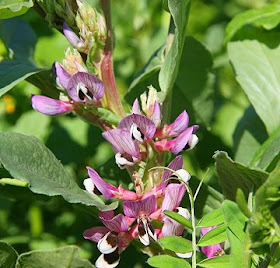So far this season has been good, nice and wet but yo-yoing from warm to cold and dry to wet, in all combinations. So we've had a start/stop in the bloom where some flower buds opened and set fruit in our warm early February, but most stalled when the weather turned unusually cold
This photo shows buds in several stages on one stem: the red "popcorn" stage buds just ready to burst open, the white petaled fully open flower, and the lower bud after pollination and petal-drop, with a tiny apricot forming inside. Those are the ones we like to see.
Meanwhile the cover crop is maturing into a lush mini-forest of green matter. Right now the orchard floor is an absolute jungle of microbes, fungi, earthworms, insects, and birds. The bell beans, peas and vetch loosen the soil with deep roots, bring soil minerals to the surface, capture nitrogen from the air, attract beneficial insects and pollinators, prevent erosion, and hold rainfall on our slopes. Later it will be mowed, left to break down and feed the microbes that then feed the soil, which then feeds the trees.
 |
| Bell beans blooming |
Mustard is another great part of the mix, with a great root system and a heavy load of pollen. Native bees, bumblebees, and honey bees all like to come.
So, for the next three weeks we're anxiously waiting to see how the fruit set turns out. We'll be hoping for mild dryer weather during peak blooms but also for more rainfall to store in the soil to get us through next summer. We're optimistic!



Yes - I really am interested, and it's all new information for me! Stunning photographs of the cover crop blossoms. (Loved the description "opportunistic" bad insects -- and the dog seems to be enjoying the jungle!)
ReplyDeleteDo you think you might ever have the time or inclination to publish all this in book form? It's the most appealing form of education I've come across in a long while.
My best wishes for the sort of weather you need, these coming weeks!!
Just lovely!
ReplyDeleteSmiles,
Camille
Wow!
ReplyDeleteNothing like some water and sunshine to make your orchard go.
And, of course, Buddy the jungle creature.
Will have to see this in person soon.